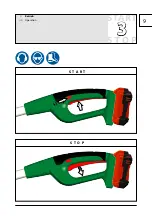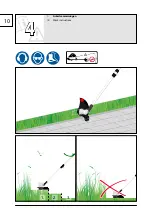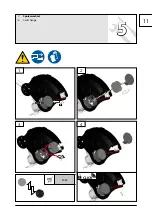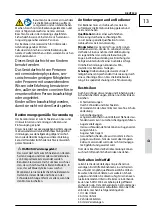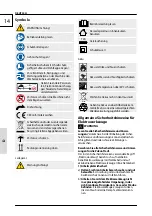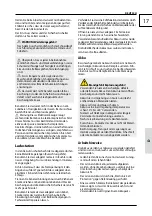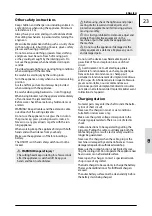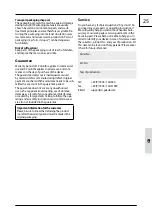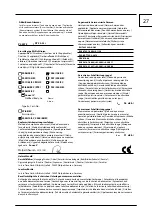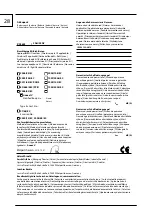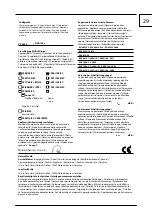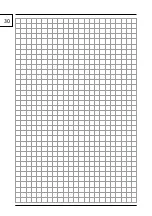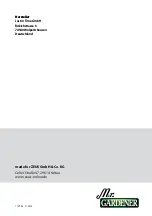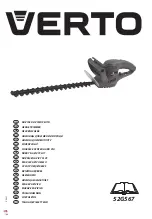
D
22
ENGLISH
GB
e) When operating a power tool outdoors, use an
extension cord suitable for outdoor use. Use of
a cord suitable for outdoor use reduces the risk of
electric shock.
f) If operating a power tool in a damp location
is unavoidable, use a residual current device
(RCprotected supply. Use of an RCD reduces the
risk of electric shock.
3) Personal safety
a) Soyez attentif, faites attention à ce que vous
faites et faites preuve de bon sens lors de
l‘utilisation de l‘appareil électrique. N‘utilisez
jamais l‘appareil électrique si vous êtes fatigué,
sous effet de drogues, d‘alcool ou de médica-
ments. A moment of inattention while operating
power tools may result in serious personal injury.
b) Use personal protective equipment. Always
wear eye protection. Protective equipment such
as dust mask, non-skid safety shoes, hard hat, or
hearing protection used for appropriate conditions
will reduce personal injuries.
c) Prevent unintentional starting. Ensure the
switch is in the off-position before connecting
to power source and/or battery pack, picking
up or carrying the tool. Carrying power tools with
your finger on the switch or energising power tools
that have the switch on invites accidents.
d) Remove any adjusting key or wrench before
turning the power tool on. A wrench or a key left
attached to a rotating part of the power tool may
result in personal injury.
e)
Do not overreach. Keep proper footing and
balance at all times. This enables better control
of the power tool in unexpected situations.
f) Dress properly. Do not wear loose clothing or
jewellery. Keep your hair, clothing and gloves
away from moving parts. Loose clothes, jewelle-
ry or long hair can be caught in moving parts.
g) If devices are provided for the connection of
dust extraction and collection facilities, ensure
these are connected and properly used. Use of
dust collection can reduce dust-related hazards.
4) Power tool use and care
a) Do not force the power tool. Use the correct po
-
wer tool for your application. The correct power
tool will do the job better and safer at the rate for
which it was designed.
b) Do not use the power tool if the switch does not
turn it on and off. Any power tool that cannot be
controlled with the switch is dangerous and must
be repaired.
c) Disconnect the plug from the power source
and/or the battery pack from the power tool
before making any adjustments, changing
accessories, or storing power tools. Such pre-
ventive safety measures reduce the risk of starting
the power tool accidentally.
d) Store idle power tools out of the reach of child-
ren and do not allow persons unfamiliar with
the power tool or these instructions to operate
the power tool. Power tools are dangerous in the
hands of untrained users.
e) Treat electric tools carefully. Check whether the
moving parts work perfectly and do not drag,
whether not broken or damaged to such an
extent that functioning of electric tools could
be affected. Have any damaged parts repaired
before using the machine. Many accidents are
caused by poorly maintained power tools.
f) Keep cutting tools sharp and clean. Properly
maintained cutting tools with sharp cutting edges
are less likely to bind and are easier to control.
g) Use the power tool, accessories and tool bits
etc. in accordance with these instructions,
taking into account the working conditions and
the work to be performed. Use of the power
tool for operations different from those intended
could result in a hazardous situation.
5) Using and treatment of cordless tools.
a) Charge the batteries only in chargers recom
-
mended by the manufacturer. Risk of fire for a
charger suitable only for a certain type of batteries
or, as appropriate, accumulators, if used for other
accumulators.
b) Use only such accumulators in this electric
appliance that have been designed for this
appliance. Use of other accumulators may lead to
injuries and risk of fire.
c) Do not leave an accumulator not being used
near office clips, coins, keys, nails, screws
or other small metal items that could cause
contact bridging. Short circuit between accumu-
lator contacts may result in burns or fire.
d)
Liquid may leak from an accumulator if used
improperly. Prevent contact with such liquid.
Rinse an affected body part with water in case
of accidental contact. If liquid gets to your eye,
seek medical advice.Liquid leaking from a battery
may cause skin irritation or burns.
6) Service
a) Have your power tool serviced by a qualified
repair person using only identical replacement
parts. This will ensure that the safety of the power
tool is maintained.
Safety instructions for Grass trimmer
Keep all parts of the body in safe distance from
the knife. Do not try to remove the material being
cut or hold material to be cut when the knife is
running. Jammed cuttings to be removed only
when the machine is off and the battery taken
out. A moment of inattention when using the hedge
trimmer may result in serious injuries.
Carry the string trimmer with the handle, with the
blade being off (idle). The battery must be remo-
ved for transport or storage of the string trimmer.
Careful treatment with the appliance reduces the risk
of injury by the blade.
Summary of Contents for 5073
Page 4: ...1 2 4 LIEFERUMFANG DELIVERED ITEMS 3 5 6 ...
Page 6: ...2 1 D Montage GB Assembly 1 3 4 2 2 3 2 TIP 90 ...
Page 7: ...3 1 D Montage GB Assembly 5 6 7 8 3 ...
Page 9: ...5 1 D Montage GB Assembly 1 3 2 2 D Arbeitshöheneinstellung GB Working height adjustment ...
Page 10: ...6 1 D Montage GB Assembly 1 A B 2 1 2 2 1 180 2 D Schnittradius GB Cutting length ...
Page 11: ...7 1 D Montage GB Assembly 1 1 2 2 CLICK 2 D Akku GB Battery 95603 2 Ah T I P ...
Page 12: ...8 1 D Montage GB Assembly 2 D Akku GB Battery 100 1 2 D Grün GB Green D Rot GB Red 1 2 ...
Page 13: ...9 1 D Montage GB Assembly S T A R T S T O P 1 2 3 D Betrieb GB Operation ...
Page 14: ...10 1 D Montage GB Assembly 4 D Arbeitsanweisungen GB Work instructions 1 3 2 ...
Page 15: ...11 1 D Montage GB Assembly 5 D Spulenwechsel GB Coill change 1 4 CLICK 3 2 1 2 5044 ...
Page 34: ...30 ...
Page 35: ...31 ...


